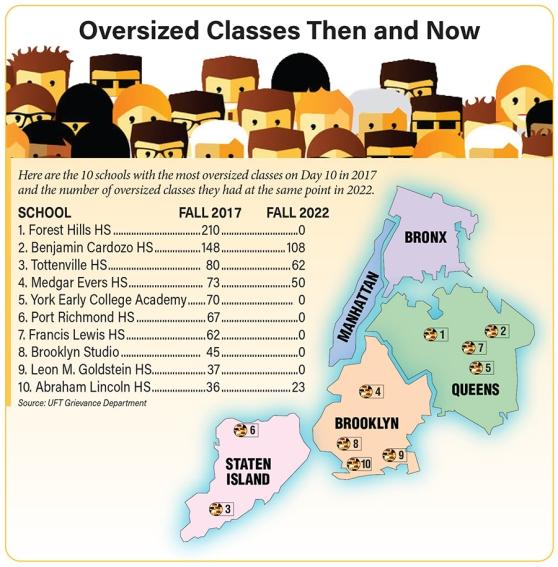Contract gets action on class size

Just two of this school year’s grievances over excessive class sizes citywide remained unresolved by Thanksgiving — thanks to a powerful provision in the 2018 Department of Education-UFT contract.
The new procedure now involves the superintendent in the resolution process, and the principals of chronically overcrowded schools no longer get a free pass.
“There was no accountability before, and what we did contractually changed that,” said James Vasquez, the UFT’s longtime Queens high school representative.
Before 2018, the union would file hundreds of class size grievances at the start of each school year. Then many of these classes remained over the contractual limits for months — sometimes as late as the following spring — as the union waited for the school’s hearing date before an independent arbitrator. In a typical pattern, union officials said, the principal would address the violation just before the hearing.
In-demand high schools in Queens — such as Forest Hills, Francis Lewis and Benjamin N. Cardozo — were notorious for having the most oversized classes in the city. But Queens was not alone. Some of the other frequent offenders were Medgar Evers HS in Brooklyn and Tottenville HS, IS 2 and PS 48 on Staten Island.
Before the 2018 contract, chapter leaders sent reports to district representatives, who would forward them to the UFT Grievance Department. If the classes were still oversized on the 10th day of school, the UFT would automatically file demands for expedited arbitration.
The 2018 contract added several more steps in the class-size resolution process before arbitration. Any cases the chapter leader and the principal don’t resolve by Day 15 go to the UFT district representative and the superintendent, who then have five days to find a solution. If they cannot, the matter goes to the Class Size Labor Management Committee on the 21st day. If the committee doesn’t figure out a remedy, the union has two days to file a demand for arbitration. The large majority of cases, however, are resolved before they get to that point.
The 2018 contract also introduced a new protocol for schools that are chronically out of compliance, meaning they have not complied with contractual class size limits for at least four of the past six years. This year, 45 schools throughout the city met the standard for that designation. The central committee meets no later than the 10th school day to address those cases. If they are not resolved, the union has two days to file a demand for arbitration.
The DOE routinely relied on the exceptions in the contract to get around lowering class sizes in overcrowded schools. But under the 2018 contractual provision, the superintendent and the union district rep have to agree to allow a school to rely on exceptions. The arbitrator also has new authority to impose a remedy if the arbitrator determines the DOE has abused the use of the exceptions. As a result, affected teachers in chronically overcrowded schools got additional preparation time or some other form of relief for as long as their classes remained oversized.
“Previously, the principal could keep the issue quiet, but now the process gets the superintendent involved and soon,” Vasquez said. “As a result, problems have basically gone away.”
Chronically overcrowded schools across the city have made strides thanks to the new process, but nowhere is the progress as striking as in Queens.
At Francis Lewis HS in Fresh Meadows, where there are 4,500 students in a school designed for 2,200, space is always at a premium, Chapter Leader Samia Wattoo said. In 2017, the school had 101 oversized classes on Day 10. In 2019, after the new contract provision took effect, there were only 13 oversized classes on the 10th day and none on the 14th day, the first year the Grievance Department collected data after Day 10 in response to the change in the process. In 2021 and again in 2022, all class size violations at the school had been resolved by Day 14.
“The principal is very on top of making sure we don’t have any oversized classrooms,” said Wattoo, who did not file any grievances on the issue this school year or last.
Dino Sferrazza, the chapter leader at Cardozo HS in Bayside, Queens, said the process for dealing with oversized classes is smoother than it used to be and oversized classes are fewer and get remedied sooner. Before the 2018 agreement, oversized classes at Cardozo would remain that way for months on end. Cardozo had 125 oversized classes in the fall of 2019, down from as many as 400 in previous years. This school year, the school had 108 oversized classes on Day 10, but by mid-October there were none.
With a lack of space and such a large student population, oversized classes at the beginning of the school year are inevitable, Sferrazza said. Equalizing classes or starting new sections is complicated because there are many moving parts and teachers have to be willing to teach an extra class for additional pay.
“Adding the superintendent into the mix early on seems to get the class sizes down to the contractual limits much quicker,” Sferrazza said, and having more people involved throughout “applies more pressure on everyone.”